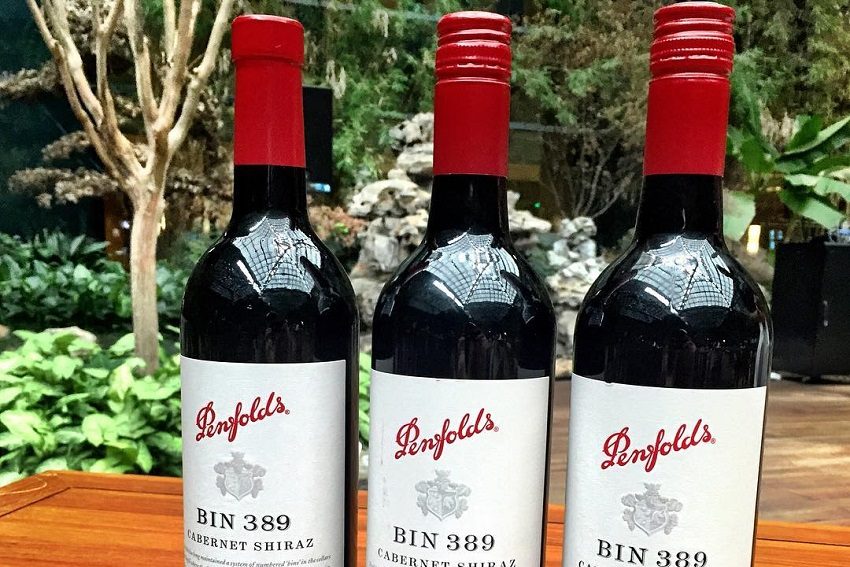Wine Fraud: Which of these wines is not like the others?

On a recent trip to Shanghai, Dave Brookes discovered not all was as it seemed when he glanced at three bottles of Penfolds Bin 389.
Some of us have become increasingly interested in the produce we eat and drink. A subset seeks a deeper connection with what we consume – be it vegetables, olive oils, coffee, tea or wine – as we like them to be farmed in a sustainable fashion, we like them to be authentic. But what if everything they told us about provenance was wrong?
Food and wine fraud is big business. Food fraud especially. It costs the global food industry an estimated US $60 billion annually while wine probably lies in the region of US $15-20 billion (mainly centered around the fine wine market). Although counterfeit olive oil, tea, coffee and shellfish are widespread, my particular area of expertise is wine, so I’ll stick to what I know.
I was recently involved in a wine show at a hotel in Shanghai and on my way to a wine business forum, passed a room with three bottles of Penfolds Bin 389 on a table. Curious, I went in and was informed that one of the bottles was legitimate and the other two were counterfeits. On closer inspection there were differences: the paper, a slightly different font colour, perhaps the machining on the screw-cap was a bit clumsier but realistically, who is going to forensically examine each bottle of wine they buy?
Three bottles of Bin 389…. One of them is legit…. Welcome to China
A post shared by Dave Brookes (@vino_freakism) on
There are plenty of guesses as to what percentage of fine wine circulating the world is fake. Conservative estimates lie around the 20 per cent mark which is in line with many luxury goods. You can double that number for Asia.
The secondary market is a major source of these counterfeit wines. It’s a place where cashed up wine collectors battle at wine auctions to get their hands on hideously expensive bottles of wine that are seen as status symbols. Scarcity and producer reputation drive up prices and wines from many of the most famous producers in the world are seen as an easy target.
While the big-guns from Penfolds (Grange and Bin 707) are targets, it is the high-ticket rock star wineries of Europe that get the most attention from counterfeiters. At the top of the list are Domaine de la Romanée Conti and Chateau Petrus which fetch stellar prices at wine auctions, closely followed by the Bordeaux first growths of Chateau Lafite Rothschild, Chateau Mouton Rothschild and Chateau Latour. The unicorn wines, much prized by wine geeks such as the Henri Jayer Cros Parantoux from Burgundy are prime targets and fake Jayer wines were recently discovered being produced in Switzerland.
Famous vintages such as 1900, 1945, 1959, 1961, 1978 and 1990 are rich targets for wily counterfeiters keen to take advantage of the secondary market bloodlust between buyers that have too much money and not enough knowledge of what they are bidding for. The title of the most counterfeited wine in the world is likely to go to the 1945 Chateau Mouton Rothschild and considering the size of the 1945 harvest in Bordeaux, Serena Sutcliffe of Sotheby’s auction house in London has said that “more 1945 had been sold than had ever been made in that famous vintage”. When you consider that a bottle of 1945 Mouton goes for $20,000-plus and 1945 Domaine de la Romanée Conti can set you back $124,000, you can see the appeal to those with nefarious intentions.
If you have an hour to spare and a Netflix subscription, the documentary Sour Grapes is worth watching to get an insight into one of the most famous and most recent wine forgery cases. Indonesian-born Rudy Kurniawan, currently languishing in a US penitentiary, was at the centre of one of the world’s largest and most audacious wine fraud cases and one that rocked the global fine wine market to its core. It’s reverberations even reached our shores when the name of an owner of one of Sydney’s top restaurants, one with a very impressive list of rare and sought after wines, was listed as one of Kurniawan’s top customers.
 Still from Sour Grapes featuring Rudy Kurniawan at a wine auction
Still from Sour Grapes featuring Rudy Kurniawan at a wine auction
Based in Los Angeles, Kurniawan made a name for himself as a wine lover with an exceptional palate and was accepted into the vinous high roller scene where it wasn’t unheard of for a group of well-heeled Hollywood types to drink $300,000 worth of wine at themed wine dinners. He had a ready market. Long story short, when the FBI finally raided Kurniawan’s Bel-Air home they found an incredibly sophisticated forgery operation. Fake labels, bottles and corks along with recipes for the world’s most sought after wines were among the mountain of evidence that put him away. In one auction alone, Kurniawan sold $25 million worth of wine and it is estimated that around 10,000 bottles of his counterfeit plonk still lie in private cellars.
I guess when it comes to rare, fine wine the best advice that can be given is: caveat emptor, or buyer beware.